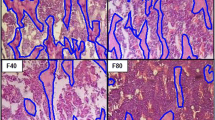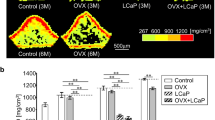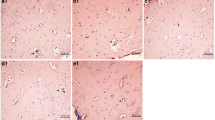Abstract
Skeletal fluorosis likely alters bone structural properties on the cortical and cancellous tissue levels in view that fluorine ion replaces bone mineral composition. Our previous study showed high bone turnover occurred in cortical bone of skeletal fluorosis. Therefore, this study further analyzed the microstructure of cancellous bone in fluorosis rats. Rats were randomly assigned into three groups: the control, low-dose fluoride group (10 mgF-/kg·day), and high-dose fluoride group (20 mgF-/kg·day). Rats were orally administered with fluoride for 1, 2, and 3 months of periods. The trabecular bone parameters of tibia were detected with micro CT and analyzed with software. The activities of glutathione peroxidase (GPX), superoxide dismutase (SOD), and the content of malondialdehyde (MDA) in serum were measured. Results showed that severity of dental fluorosis rose with the increase of dose and prolongation of fluoride exposure. Meantime, the poorer connectivity and less trabecular bone network were observed in cancellous bone of rats treated with fluoride. Data analysis indicated that fluoride treatment significantly decreased bone volume and connectivity degree, but amplified trabecular space in 1 and 2 months of periods. Intriguingly, trabecular thickness significantly decreased in 1-month high-dose fluoride group, but returned to the control in 3 months of period. Fluoride treatment mainly inhibited the GPX activity and increased the MDA level to activate oxidative stress. This study confirmed that excessive fluoride impaired cancellous bone and caused redox imbalance.





Similar content being viewed by others
Data Availability
Some or all data and models during the study are available from the corresponding author on reasonable request.
References
Li MJ, Qu XN, Hong MH et al (2020) Spatial distribution of endemic fluorosis caused by drinking water in a high-fluorine area in Ningxia, China. Environ Sci Pollut Res Int 27(16):20281–20291. https://doi.org/10.1007/s11356-020-08451-7
Mohammadi AA, Yousefi M, Yaseri M et al (2017) Skeletal fluorosis in relation to drinking water in rural areas of West Azerbaijan. Iran Sci Rep 7(1):17300. https://doi.org/10.1038/s41598-017-17328-8
Onipe T, Edokpayi JN, Odiyo JO (2020) A review on the potential sources and health implications of fluoride in groundwater of Sub-Saharan Africa. J Environ Sci Health A Tox Hazard Subst Environ Eng 55(9):1078–1093. https://doi.org/10.1080/10934529.2020.1770516
Meena L, Gupta R (2021) Skeletal fluorosis. N Engl J Med 385(16):1510. https://doi.org/10.1056/NEJMicm2103503
Kurdi MS (2016) Chronic fluorosis: the disease and its anaesthetic implications. Indian J Anaesth 60(3):157–162. https://doi.org/10.4103/0019-5049.177867
Boivin G, Chavassieux P, Chapuy MC et al (1989) Skeletal fluorosis: histomorphometric analysis of bone changes and bone fluoride content in 29 patients. Bone 10:89–99
Collins MT, Marcucci G, Anders H et al (2022) Skeletal and extraskeletal disorders of biomineralization. Nat Rev Endocrinol 18(8):473–489. https://doi.org/10.1038/s41574-022-00682-7
Cook FJ, Seagrove-Guffey M, Mumm S et al (2021) Non-endemic skeletal fluorosis: causes and associated secondary hyperparathyroidism (case report and literature review). Bone 145:115839. https://doi.org/10.1016/j.bone.2021.115839
Bian S, Hu A, Lu G et al (2022) Study of chitosan ingestion remitting the bone damage on fluorosis mice with micro-CT. Biol Trace Elem Res 200(5):2259–2267. https://doi.org/10.1007/s12011-021-02838-4
Eriksen EF (2010) Cellular mechanisms of bone remodeling. Endocr Metab Disord. 11(4):219–227. https://doi.org/10.1007/s11154-010-9153-1
Ma R, Liu S, Qiao T et al (2020) Fluoride inhibits longitudinal bone growth by acting directly at the growth plate in cultured neonatal rat metatarsal bones. Biol Trace Elem Res 2:522–532. https://doi.org/10.1007/s12011-019-01997-9
Kouk S, Rapp TB (2020) Excision of prominent bony mass due to skeletal fluorosis. JBJS Case Connector 10(2):e0107. https://doi.org/10.2106/JBJS.CC.19.00107
Srivastava S, Flora SJS (2020) Fluoride in drinking water and skeletal fluorosis: a review of the global impact. Curr Environ Health Rep 7:140–146. https://doi.org/10.1007/s40572-020-00270-9
Varol E, Icli A, Aksoy F et al (2013) Evaluation of total oxidative status and total antioxidant capacity in patients with endemic fluorosis. Toxicol Ind Health 29:175–180. https://doi.org/10.1177/0748233711428641
Barbier O, Arreola-Mendoza L, Del Razo LM (2010) Molecular mechanisms of fluoride toxicity. Chem Biol Interact 188:319–333
Dean HT (1936) Chronic endemic dental fluorosis (motted enamel). JAMA 107(16):1269–1273. https://doi.org/10.1001/jama.1936.02770420007002
Jarquín-Yañez L, Mejiá-Saavedra JDJ, Molina-Frechero N, G et al (2015) Association between urine fluoride and dental fluorosis as a toxicity factor in a rural community in the state of San Luis Potosi. Sci World J 647184. https://doi.org/10.1155/2015/647184.
Rezaee T, Bouxsein ML, Karim L (2020) Increasing fluoride content deteriorates rat bone mechanical properties. Bone 136:115369. https://doi.org/10.1016/j.bone.2020.115369
Mousny M, Omelon S, Wise L et al (2008) Fluoride effects on bone formation and mineralization are influenced by genetics. Bone 43:1067–1074. https://doi.org/10.1016/j.bone.2008.07.248
Fina BL, Lupo M, Ros ERD et al (2018) Bone strength in growing rats treated with fluoride: a multi-dose histomorphometric, biomechanical and densitometric study. Biol Trace Elem Res 185(2):375–383. https://doi.org/10.1007/s12011-017-1229-2
Sun F, Li X, Yang C et al (2014) A role for PERK in the mechanism underlying fluoride-induced bone turnover. Toxicology 325:52–66. https://doi.org/10.1016/j.tox.2014.07.006
Fina BL, Lombarte M, Rigalli JP, Rigalli A (2014) Fluoride increases superoxide production and impairs the respiratory chain in ROS 17/2.8 osteoblastic cells. PLoS ONE 9(6):e100768. https://doi.org/10.1371/journal.pone.0100768
Karaoz E, Oncu M, Gulle K et al (2004) Effect of chronic fluorosis on lipid peroxidation and histology of kidney tissues in first- and second-generation rats. Biol Trace Elem Res 102:199–208. https://doi.org/10.1385/BTER:102:1-3:199
Funding
This research is supported by the National Natural Science Foundation of China [Grant No. 81673111].
Author information
Authors and Affiliations
Contributions
H.L.: writing—original draft preparation, methodology. X.C.: investigation and validation; Z.Z.: data validation. J.Z., the conception of the study. H.X.: writing—review and editing, data curation, resources project administration, and funding acquisition. All authors have read and agreed to the published version of the manuscript.
Corresponding author
Ethics declarations
Conflict of Interest
The authors declare no competing interests.
Additional information
Publisher’s Note
Springer Nature remains neutral with regard to jurisdictional claims in published maps and institutional affiliations.
Rights and permissions
Springer Nature or its licensor (e.g. a society or other partner) holds exclusive rights to this article under a publishing agreement with the author(s) or other rightsholder(s); author self-archiving of the accepted manuscript version of this article is solely governed by the terms of such publishing agreement and applicable law.
About this article
Cite this article
Li, H., Chen, X., Zhang, Z. et al. Microstructural Analysis of Cancellous Bone in Fluorosis Rats. Biol Trace Elem Res 201, 4827–4833 (2023). https://doi.org/10.1007/s12011-023-03564-9
Received:
Accepted:
Published:
Issue Date:
DOI: https://doi.org/10.1007/s12011-023-03564-9




